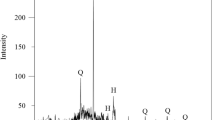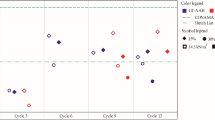Abstract
Stabilized/solidified hazardous wastes may lose their structural integrity and stability when exposed to long-term extreme weather conditions, such as repeated wetting–drying and freezing–thawing (F–T). This situation causes wastes to become environmentally risky again even if they are stabilized and solidified. In this study, the effects of F–T cycles on the strength and pollutant leachability of stabilization/solidification (S/S) products of zinc extraction residue (ZER) stabilized/solidified by Portland cement (PC), fly ash (FA), and alkaline phosphate (AP) were comprehensively investigated. S/S efficiency and F–T resistance of the samples were determined by unconfined compressive strength (UCS), and leaching tests widely applied in the USA (TCLP), European Union (EN-12457/1-4 2020), and Turkey (TS-EN 12457/4). In addition, X-ray diffraction (XRD) and scanning electron microscopy (SEM) analyses and visual inspection were performed to examine the variations in mineralogical and morphological structures. S/S efficiency and F–T resistance changed depending on the type and amount of S/S reagent used and decreased in the order of PC+AP>PC>>FA. All applied S/S procedures, except for 10% PC addition, were found to be suitable for the S/S of ZER from the viewpoint of the achievement of the minimum required strength and pollutant leachability. F–T events did not change the mineralogical structures of the S/S products, but significantly reduced the UCS value by causing structural deformation. The pollutant concentrations released from the samples that lost their monolithic structure by crumbling after certain cycle increased with the increasing F–T cycle, causing a change in the storage criteria of the samples. Therefore, it is important to consider and apply the F–T cycle as a standard test in addition to the existing leaching and strength tests for S/S products of the wastes in terms of minimizing environmental risks.










Similar content being viewed by others
References
Chen QY, Tyrer M, Hills CD, Yang XM, Carey P (2009) Immobilization of heavy metal in cement-based solidification/stabilization: a review. Waste Manag 29:390–403
Conner JR, Hoeffner SL (1998) The history of stabilization/solidification technology. Crit Rev Environ Sci Technol 28:325–396
Coudert L, Bondu R, Rakotonimaro TV, Rosa E, Neculita CM (2020) Treatment of As-rich enamel effluents and produced residues stability: current knowledge and research priorities for gold mining. J Hazard Mater:386
Council Decision (2003) Establishing criteria and procedures for the acceptance of waste at landfills pursuant to Article 16 of and Annex II to Directive 1999/31/EC. https://eur-lex.europa.eu/legal-content/GA/TXT/?uri=celex:32003D0033.
El-eswed BI (2020) Chemical evaluation of immobilization of wastes containing Pb, Cd, Cu and Zn in alkali-activated materials: a critical review. J Environ Chem Eng 8:104194
EN-12457/1-4 (2020) Characterization of waste leaching compliance test for leaching of granular waste materials and sludges Part 4: one stage batch test at a liquid to solid ratio of 10 l/kg for materials with particle size below 10 mm (without or with size reduction). https://standards.cen.eu/dyn/www/f?p=204:110:0::::FSP_PROJECT, FSP_ORG_ID:14489,2046877&cs=15ABE8C36B9C1F3F6AC6FACF0CD6B07F8. Accessed 14 October 2020
Erdem M, Özverdi A (2011) Environmental risk assessment and stabilization solidification of zinc extraction residue II stabilization solidification. Hydrometallurgy 105:270–276
Georgescu M, Mohanu I, Voicu G, Coţofană V (2012) Physical-chemical processes at hardening of some lime-limestone-volcanic tuff composites, UPB Sci Bul. Series B 74(1):131–142
Guo B, Liu B, Yang J, Zhang S (2017) The mechanisms of heavy metal immobilization by cementitious material treatments and thermal treatments: a review. J Environ Manag 193:410–422
Li G, Wang F, Ma W, Fortier R, Mu Y, Mao Y, Hou X (2018) Variations in strength and deformation of compacted loess exposed to wetting-drying and freeze-thaw cycles. Cold Reg Sci Technol 151:159–167
Liu J, Zha F, Xu L, Kang B, Liu Z (2020) Zinc leachability in contaminated soil stabilized/solidified by cement-soda residue under freeze-thaw cycles. Appl Clay Sci:186
Lu Y, Liu S, Zhang Y, Li Z, Xu L (2020) Freeze-thaw performance of a cement-treated expansive soil. Cold Reg Sci Technol:170
Ma W, Chen D, Pan M, Gu T, Zhong L, Chen G, Yan B, Cheng Z (2019) Performance of chemical chelating agent stabilization and cement solidification on heavy metals in MSWI fly ash: a comparative study. J Environ Manag 247:169–177
Malviya R, Chaudhary R (2006) Factors affecting hazardous waste solidification/stabilization: a review. J Hazard Mater 137:267–276
Marfunin AS (1994) Advanced mineralogy: composition, structure, and properties of mineral matter: concepts, results, and problems. Springer, Berlin, Heidelberg
Ouhadi VR, Yong RN, Deiranlou M (2021) Enhancement of cement-based solidification/stabilization of a Lead-contaminated smectite clay. J Hazard Mater:403
Scanferla P, Ferrari G, Pellay R, Ghirardini AV, Zanetto G, Libralato G (2009) An innovative stabilization/solidification treatment for contaminated soil remediation: demonstration project results. J Soils Sediments 9:229–236
Senneca O, Cortese L, Di-Martino R, Fabbricino M, Ferraro A, Race M, Scopino A (2020) Mechanisms affecting the delayed efficiency of cement based stabilization/solidification processes. J Clean Prod 261
TS EN 12457-4 (Eluate Test) (2004) Characterization of wastes - extraction analysis from solid - conformity test for solid extraction of granular solid wastes and sludges - Part 4: one-stage batch test for materials with a liquid solid ratio of 10 l/kg and a particle size of less than 10 mm (reduced or not reduced). https://intweb.tse.org.tr/Standard/Standard/StandardAra.aspx.
USEPA Method 1311 (1992) Toxicity characterization leaching procedure (TCLP). https://www.epa.gov/sites/production/files/2015-12/documents/1311.pdf.
USEPA (1993) Solidification/stabilization and its application to waste materials. https://nepis.epa.gov/Exe/ZyPDF.cgi/2000DYKB.PDF?Dockey=2000DYKB.PDF.
Vogel AI (1979) Vogel’s textbook of macro and semimicro qualitative inorganic analysis. Fifth edition, revized by G. Svehla. New York: Longman Inc
Wan Q, Rao F, Song S, Zhang Y (2019) Immobilization forms of ZnO in the solidification/stabilization (S/S) of a zinc mine tailing through geopolymerization. J Mater Res Technol 8:5728–5735
Wang A, Zheng Y, Zhang Z, Liu K, Li Y, Shi L, Sun D (2020) The durability of alkali-activated materials in comparison with ordinary Portland cements and concretes: a review. Engineering 6:695–706
Wei ML, Du YJ, Reddy KR, Wu HL (2015) Effects of freeze-thaw on characteristics of new KMP binder stabilized Zn-and Pb-contaminated soils. Environ Sci Pollut Res 22:19473–19484
Xi Y, Wang H, Guo L, Zhang M (2018) Utilization of cement and other additives for solidification/stabilization of soil contaminated simulataneously with Cd2+ and Pb2+ ions. Environ Prot Eng 44:61–73
Xue Q, Li JS, Liu L (2013) Effect of compaction degree on solidification characteristics of Pb-contaminated soil treated by cement. Clean-Soil Air Water 41:1–7
Yakubu Y, Zhou J, Ping D, Shu Z, Chen Y (2018) Effects of pH dynamics on solidification/stabilization of municipal solid waste incineration fly ash. J Environ Manag 207:243–248
Yang Z, Li X, Li D, Wang Y, Liu X (2020) Effects of long-term repeated freeze-thaw cycles on the engineering properties of compound solidified/stabilized Pb-contaminated soil: deterioration characteristics and mechanisms. Int J Environ Res Public Health:17
Acknowledgements
This study was supported by the Fırat University Scientific Research Projects Unit (FUBAP) [project number of MF.19.06].
Availability of data and materials
All data generated or analyzed during this study are included in this published article.
Funding
This work was supported by the Fırat University Scientific Research Projects Unit (FUBAP) [project number of MF.19.06].
Author information
Authors and Affiliations
Contributions
All authors contributed to the study conception and design. Material preparation, data collection, and analysis were performed by MMD and ME. The first draft of the manuscript was written by ME and all authors commented on previous versions of the manuscript. All authors read and approved the final manuscript.
Corresponding author
Ethics declarations
Ethics approval and consent to participate
Not applicable.
Consent for publication
Not applicable.
Competing interests
The authors declare no competing interests.
Additional information
Responsible Editor: Ta Yeong Wu
Publisher’s note
Springer Nature remains neutral with regard to jurisdictional claims in published maps and institutional affiliations.
Rights and permissions
About this article
Cite this article
Deniz, M.M., Erdem, M. Effect of freezing–thawing cycles on the strength and pollutant leachability of stabilized/solidified metallurgical waste. Environ Sci Pollut Res 28, 49014–49031 (2021). https://doi.org/10.1007/s11356-021-14064-5
Received:
Accepted:
Published:
Issue Date:
DOI: https://doi.org/10.1007/s11356-021-14064-5




